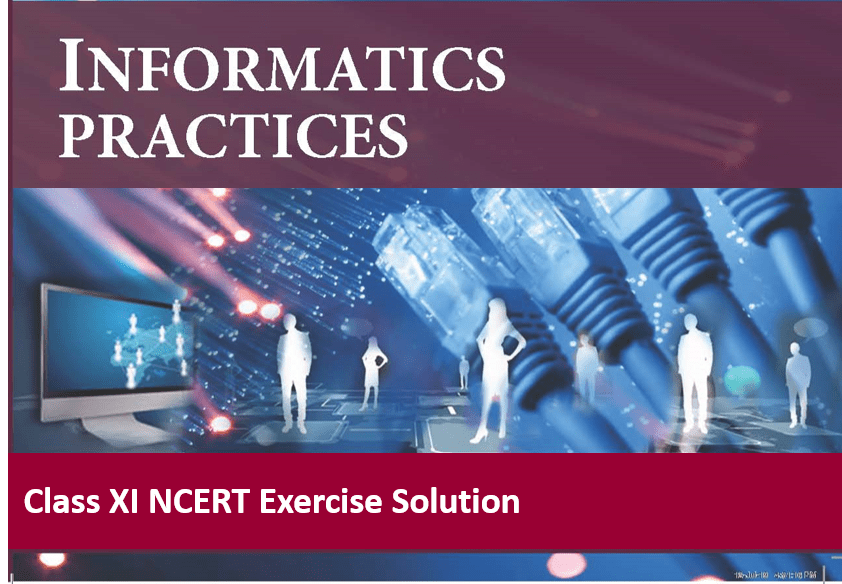CBSE NCERT Exercise Solution of Class 11 Informatics Practices
Chapter 7 – Database Concepts
A quick revision
File : A file in a file system is a container to store data in a computer.
Disadvantage of File System : File system suffers from Data Redundancy, Data Inconsistency, Data Isolation, Data Dependence and Controlled Data sharing.
DBMS : Database Management System (DBMS) is a software to create and manage databases. A database is a collection of tables.
Database Schema : Database schema is the design of a database
Database Constraint : A database constraint is a restriction on the type of data that that can be inserted into the table.
Database Catalog : Database schema and database constraints are stored in database Catalog.
Database Instance : Whereas the snapshot of the database at any given time is the database instance.
Query : A query is a request to a database for information retrieval and data manipulation (insertion, deletion or update). It is written in Structured Query Language (SQL).
RDBMS : Relational DBMS (RDBMS) is used to store data in related tables. Rows and columns of a table are called tuples and attributed respectively. A table is referred to as a relation.
Keys in Database : Destructions on data stored in a RDBMS is applied by use of keys such as Candidate Key, Primary Key, Composite Primary Key, Foreign Key.
Primary Key: Primary key in a relation is used for unique identification of tuples.
Foreign Key : Foreign key is used to relate two tables or relations.
Attributes / Columns : Each column in a table represents a feature (attribute) of a record. Table stores the information for an entity whereas a row represents a record.
Tuples : Each row in a table represents a record. A tuple is a collection of attribute values that makes a record unique.
Tuple vs Attribute : A tuple is a unique entity whereas attribute values can be duplicate in the table.
SQL : SQL is the standard language for RDBMS systems like MySQL.
NCERT Exercise Solution Ch 7 Database Concepts
1. Give the terms for each of the following:
a) Collection of logically related records.
Answer: Table / Relation
b) DBMS creates a file that contains description about the data stored in the database.
Answer: Data dictionary
c) Attribute that can uniquely identify the tuples in a relation.
Answer: Primary Key
d) Special value that is stored when actual data value is unknown for an attribute.
Answer: NULL
e) An attribute which can uniquely identify tuples of the table but is not defined as primary key of the table.
Answer: Alternate Key
f) Software that is used to create, manipulate and maintain a relational database.
Answer: Database Management System (DBMS), e.g. MySQL, Oracle,
2. Why foreign keys are allowed to have NULL values? Explain with an example.
Answer: The value of foreign key is derived from the Primary key of the primary table. Sometimes, we want to enter a record, which is not related. To handle this situation, it is allowed to enter NULL value in the foreign key.
For example, Suppose a shopkeeper want to sale the product, but the customer is not a regular customer, so his customer id is not exist. In this case, NULL value is entered to the customerId field.
3. Differentiate between:
a) Database state and database schema
Answer: Database State / Instance :- The data stored in database at a particular moment time of time i.e. the state of the database at a particular instance of time, is called instance of database.
Database Schema :- The logical structure and design of a database is called the database schema. It is the blueprint or skeleton structure of a database.
b) Primary key and foreign key
Answer: Primary Key :- Primary key is a column or group of columns in a table that uniquely identify the records in the table.
Foreign Key:- Foreign keys are the columns of the table which refer to the primary key of another table. A foreign key creates a relationship between two tables.
c) Degree and cardinality of a relation
Answer: Degree :- Degree refers to the number of columns or attributes in a relation/table.
Cardinality :- Cardinality refers to the number of rows / records / tuples in a relation/table.
4. Compared to a file system, how does a database management system avoid redundancy in data through a database?
Answer: A database stores the data at a central location from where all application programs can access data. This avoids to save the same data in multiple files, thus it reduces data redundancy.
Class 11 Informatics Practices – NCERT Book exercise Solution







